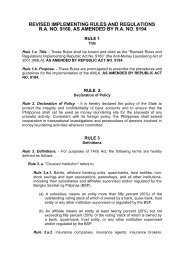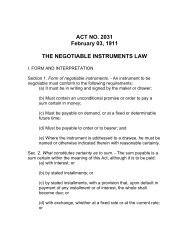Women at the Helm - Planters Development Bank
Women at the Helm - Planters Development Bank
Women at the Helm - Planters Development Bank
You also want an ePaper? Increase the reach of your titles
YUMPU automatically turns print PDFs into web optimized ePapers that Google loves.
The good news: you can get everything th<strong>at</strong> you want…eventually. But because SMEs have limited resources (bydefinition), it first becomes an issue of priorities. Youhave to know wh<strong>at</strong> is most important to accomplish <strong>at</strong><strong>the</strong> moment. Then th<strong>at</strong>’s where you focus your metrics.As <strong>the</strong> person on top of things, your job is to digest<strong>the</strong> business situ<strong>at</strong>ion and decide on wh<strong>at</strong> your prioritythrust should be for now. Perhaps (as an example) itis <strong>the</strong> stabiliz<strong>at</strong>ion of your cash flow—maybe <strong>the</strong> 15thand 30th of <strong>the</strong> month has always been a source ofstress, and you want to fix this before proceeding withanything else.You can only get a predictable cash flow if youhave predictable sales. So how do you get a morepredictable sales p<strong>at</strong>tern? This is where <strong>the</strong> str<strong>at</strong>egy partcomes in.One possible str<strong>at</strong>egy: find a way to make your businessfit into a subscription model. Subscription implies aregular, periodic cash flow. Perhaps you can arrangefor a regular auto-debit from your clients’ credit cardsor bank accounts. This way, you get to benefit from avirtually habitual buying behavior.Fine. So wh<strong>at</strong> metric will help you implement such astr<strong>at</strong>egy? Well, we can start with <strong>the</strong> simple: number of netsubscriptions gained. You may want to set a target th<strong>at</strong>’sbased on how much cash flow you need. For instance,“Gain 1,000 subscribing clients by <strong>the</strong> end of <strong>the</strong> year.”Now th<strong>at</strong> you have your str<strong>at</strong>egic objective, you cannext transl<strong>at</strong>e this into an implement<strong>at</strong>ion timetableth<strong>at</strong> you can monitor via metrics. How? Perhaps set <strong>at</strong>arget of, say, gaining 100 net additional subscribersper month. Henceforth, you evalu<strong>at</strong>e your performancebased on how well you achieve this goal.Okay, th<strong>at</strong> was easy. Now let’s get into a bit more of a challenge.Monitoring product qualityIf you manufacture products, <strong>the</strong>n you will have toknow a bit about how to evalu<strong>at</strong>e quality in youroutput. This typically involves spotting defects and,generally, minimizing <strong>the</strong> number of defects per volumeof output. Large-scale manufacturers toler<strong>at</strong>e justfractions of percents in defects. Smaller manufacturers,unfortun<strong>at</strong>ely, do not have <strong>the</strong> autom<strong>at</strong>ed processestypically needed to <strong>at</strong>tain such near-perfection. You can,however, aim for minimizing defect r<strong>at</strong>es as a goal.Start by clearly defining wh<strong>at</strong> a “defect” is. This meansth<strong>at</strong> you have to set standards for your output. Thisis best done for you by a manufacturing expert, suchas an engineer. Once th<strong>at</strong> set of standards have beenestablished, you can start monitoring by having aquality checker go through a checklist and determining<strong>the</strong> number of defective products made. Henceforth,every time a defect is spotted, <strong>the</strong> tally is upped and <strong>the</strong>process is re-studied and improved, with <strong>the</strong> objectiveof preventing th<strong>at</strong> defect from happening again.Monitoring service qualityUnlike products, service quality is more difficult tomonitor. For one thing, if you yourself try to avail ofyour business’s services, chances are th<strong>at</strong> you’ll getexcellent service—because your staff will be afraid ofgetting <strong>the</strong> boss mad. This means th<strong>at</strong> monitoring willhave to happen even when you are not around.But services tend to be very priv<strong>at</strong>e affairs between yourservice crew and <strong>the</strong> clients, so one option is to haveyour own clients do <strong>the</strong> evalu<strong>at</strong>ing for you. You see<strong>the</strong>se in <strong>the</strong> form of Customer S<strong>at</strong>isfaction R<strong>at</strong>ing cardsth<strong>at</strong> restaurants regularly hand out, for instance.When designing such r<strong>at</strong>ing cards, make sure to cre<strong>at</strong>eprovisions to allow <strong>the</strong>m to quantify <strong>the</strong>ir answers. Thisis often done via Likert scales, which are scales th<strong>at</strong> gofrom 1 to 10, 0 to 100, and so on. Scales are importantbecause it’s your chance to get hard numbers aboutcustomer experience.The challenge: it is difficult for customers to r<strong>at</strong>e yourperformance on a standalone basis. For instance, wh<strong>at</strong>will <strong>the</strong>ir basis be for saying th<strong>at</strong> you’re an 8 out of10? It becomes way too arbitrary. The secret weaponth<strong>at</strong> you can use: instead of asking your clients to r<strong>at</strong>eyou alone, ask <strong>the</strong>m to r<strong>at</strong>e you as well as your closestcompetitors. This way, you can measure <strong>the</strong> “qualitygap” between you and your competitor, r<strong>at</strong>her than justyour r<strong>at</strong>ing alone.For instance, if competitor X was given a r<strong>at</strong>ing of 75while you were given a r<strong>at</strong>ing of 80, <strong>the</strong>n your qualitygap stands <strong>at</strong> +5. Your objective may now be to increase<strong>the</strong> gap to, say +15. So, you will henceforth regularlyassess your quality r<strong>at</strong>ings and have targets per period.For instance, perhaps by <strong>the</strong> following month yourcompetitor is r<strong>at</strong>ed <strong>at</strong> 72 while you get an 82, leadingto a quality gap of +10. Note th<strong>at</strong> gap analysis doesn’tmean th<strong>at</strong> your competitor’s quality is deterior<strong>at</strong>ing(you have no control over th<strong>at</strong>). R<strong>at</strong>her, your clients areautom<strong>at</strong>ically adjusting <strong>the</strong>ir r<strong>at</strong>ing scheme to fit <strong>the</strong>perceived gap between you and your competitor. Andth<strong>at</strong>’s really wh<strong>at</strong> you’re after.Designing metrics for monitoring and pushingperformance need not be a difficult science. All it takesis a very clear idea of wh<strong>at</strong> you want to accomplish, aswell as a street-smart approach to determining whichnumbers make <strong>the</strong> most sense for you to monitor.SME | 15
















